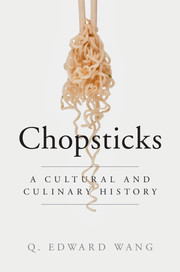Book contents
- Frontmatter
- Dedication
- Contents
- Acknowledgments
- List of Plates
- Timeline
- Map of East Asia
- 1 Introduction
- 2 Why chopsticks? Their origin and original function
- 3 Dish, rice or noodle? The changing use of chopsticks
- 4 Forming a chopsticks cultural sphere: Vietnam, Japan, Korea and beyond
- 5 Using chopsticks: customs, manners and etiquette
- 6 A pair inseparable: chopsticks as gift, metaphor and symbol
- 7 “Bridging” food cultures in the world
- Conclusion
- Glossary
- Bibliography
- Index
- Plate section
- References
3 - Dish, rice or noodle? The changing use of chopsticks
Published online by Cambridge University Press: 05 February 2015
- Frontmatter
- Dedication
- Contents
- Acknowledgments
- List of Plates
- Timeline
- Map of East Asia
- 1 Introduction
- 2 Why chopsticks? Their origin and original function
- 3 Dish, rice or noodle? The changing use of chopsticks
- 4 Forming a chopsticks cultural sphere: Vietnam, Japan, Korea and beyond
- 5 Using chopsticks: customs, manners and etiquette
- 6 A pair inseparable: chopsticks as gift, metaphor and symbol
- 7 “Bridging” food cultures in the world
- Conclusion
- Glossary
- Bibliography
- Index
- Plate section
- References
Summary
At your birth when they first hung out the bow, I was the most honored guest at the birthday feast. Wielding my chopsticks I ate boiled noodles, and composed a congratulatory poem on a heavenly unicorn.
Liu Yuxi (772–842)The discovery of a new dish does more for the happiness of mankind than the discovery of a star.
Anthelme Brillat-Savarin, Physiologie du Gout (1825)In his masterpiece, Records of the Grand Historian, Sima Qian relates many fascinating episodes happening during the Han dynasty (206 bce to 220 ce), a great era in early imperial China. Some of them, interestingly, feature chopsticks. In his biographical account of Liu Bang (256–195 bce), Sima records that while preparing to seize power, Liu, who grew up in northern Jiangsu near Longqiuzhuang and later became Emperor Gaozu after founding the dynasty, once considered a strategic plan by a counselor over a meal. But Zhang Liang (256–186 bce), his main and most trusted advisor, opposed it. In order to persuade Liu, Zhang borrowed several chopsticks and made a strong counterargument. And he prevailed in the end; Liu decided to adopt his plan instead. Sima does not tell exactly how Zhang used chopsticks to explain his objection. But the story has been well remembered in history ever since. It reveals that Liu and his staff, among others, used chopsticks in eating their food.
Chopsticks appear in another biography in the Records of the Grand Historian. Its protagonist is Zhou Yafu (199–143 bce), a distinguished and capable general under Han Emperors Wen (r. 176–157 bce) and Jing (r. 157–141 bce), son and grandson of Emperor Gaozu. Thanks to his remarkable accomplishments, Zhou became trusted by both emperors during most of their reigns. But in the end, perhaps due to his arrogance, Zhou lost Emperor Jing’s trust. Sima records an episode in which one day Zhou was summoned to court to dine with the Emperor and found a big chunk of meat in his food tray with no sliced pieces, nor chopsticks. He turned around asking for chopsticks, only to be mocked by the Emperor: “Was this treatment not good enough for you?” Feeling insulted and humiliated, Zhou thanked the Emperor and left the court without touching the food.
- Type
- Chapter
- Information
- ChopsticksA Cultural and Culinary History, pp. 41 - 66Publisher: Cambridge University PressPrint publication year: 2015



